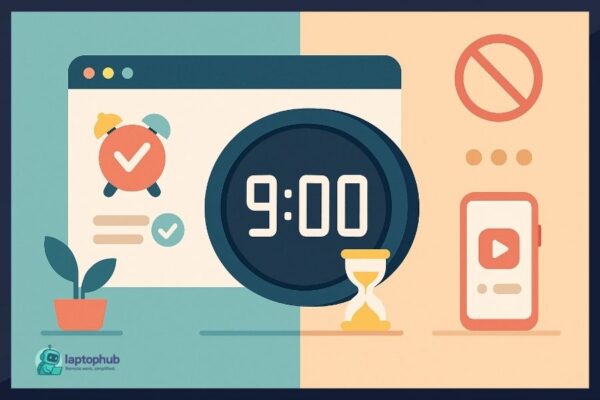It starts innocently enough.
You sit down to work on that client proposal… but decide you should make coffee first. Maybe answer a few texts. Suddenly, you’re knee-deep in a three-hour TikTok rabbit hole, and the day feels lost.
Sound familiar?
As someone who’s freelanced full-time for years, I can tell you: working from home is a blessing—and a battlefield.
No boss breathing down your neck, but also no one stopping you from procrastinating yourself into oblivion.
Beating procrastination isn’t about trying harder; it’s about working smarter—building habits, environments, and mindsets that help you stay on track without draining your willpower dry. Here’s what I’ve learned the hard way—and what will actually help you make real progress.
💡Key takeaways:
- Building routines, micro-habits, and workspace structure is crucial to naturally overcoming procrastination at home.
- Breaking large projects into small actionable steps reduces overwhelm and helps generate momentum.
- Smart accountability systems and time management strategies can significantly boost remote work productivity.
- Protecting mental health and embracing progress over perfection are essential to sustaining long-term focus.
Why Procrastination Hits Harder at Home
Understanding procrastination is the first step toward beating it.
In my experience (and plenty of studies back this up), we procrastinate because of:
- Lack of boundaries: Home is full of “optional” distractions.
- Task aversion: We avoid tasks that feel boring, confusing, or overwhelming.
- Decision fatigue: Too much flexibility leads to paralysis.
- Isolation: Without the energy of a team around, motivation drops.
- Perfectionism: Fear of not doing it perfectly makes us not do it at all.
Knowing these triggers helps you tackle them at the root—rather than just slapping another productivity app on top.
1. Build a “Commute Ritual” to Kickstart Focus
One thing I desperately missed when I first went remote was the mental transition a commute gives you. Without it, it felt like the couch was calling my name all day.
To fix that, I created a simple daily ritual that signals “work mode”:
- Pouring my coffee
- Lighting a candle at my desk
- Writing a quick to-do list before I open emails
This tiny, repeatable routine builds a psychological bridge into productivity. Try crafting your own. Even a two-minute ritual can change the tone of your whole day.
🖥️Also read: How to Stick to a Routine: 10 Steps That Actually Work
2. Break Work Into Ridiculously Small Steps
When I feel paralyzed by a big project, it’s usually because my brain sees it as one huge, impossible task.
Instead, I slice it into microscopic pieces—tiny enough that they feel almost silly not to start.
For example, instead of “write blog post,” my steps look like:
- Write rough title ideas (5 min)
- Jot 3 bullet points for each main section (10 min)
- Draft intro paragraph (15 min)
Microsteps create momentum. And momentum makes motivation show up—not the other way around.
3. Time-Block Your Day (and Defend Those Blocks)
Without structure, your day will dissolve into chaos—trust me, I’ve been there.
That’s why I block my day into focus periods and defend them like appointments with a VIP client.
Typical time blocks:
- 9–11 AM: Deep work (writing, strategy)
- 11–12 PM: Admin (emails, invoices)
- 1–3 PM: Client meetings or calls
- 3–4 PM: Buffer/catch-up
You don’t have to stick to the minute, but starting with intention beats reacting all day.
4. Embrace the “Two-Minute Rule” Religiously
If something takes less than two minutes?
Handle it right now.
Sending a quick email reply, confirming a Zoom meeting, saving a receipt—these tiny tasks pile up fast if you delay them. Tackling them immediately frees up massive mental space for your real priorities.
5. Let Yourself “Procrastinate”—On Purpose
Counterintuitive? Maybe.
Effective? Absolutely.
Instead of trying to suppress every urge to procrastinate, I schedule it. After 90 minutes of deep focus, I allow 10–15 minutes for mindless stuff: scrolling Instagram, grabbing a snack, stretching.
This permission keeps distractions contained—and prevents them from swallowing entire afternoons.
6. Master Your Workspace: More Than Just a Desk
You already know having a dedicated workspace matters. But small, often-overlooked factors make a bigger difference than you think:
- Lighting: Natural light = alertness; dim light = sluggishness.
- Temperature: Studies show a slightly cooler room sharpens focus.
- Chair and desk height: Physical discomfort breeds mental fidgeting.
You don’t need a Pinterest-worthy office. You just need an environment that whispers, “You’re here to work.”
🖥️Also read: 10 Clever Dollar Store Hacks for an Organized Home Office
7. Prioritize Ruthlessly (One Thing at a Time)
Every morning, I identify one “must-do” item.
Not five. One.
No matter what chaos the day throws at me, if I complete that task, I call it a win.
Over time, those wins compound into major progress.
Ask yourself: “If I only completed one thing today, what would make me feel accomplished?”
Then guard it fiercely.
8. Reframe Action as Progress, Not Perfection
Waiting for inspiration or the perfect conditions is a fast-track to procrastination.
Instead, I remind myself: “Start messy. Fix later.”
Perfection is a moving target. Progress is momentum.
The first draft, the rough sketch, the ugly outline—they’re supposed to be bad.
Starting is what matters.
9. Find a “Body Double” for Accountability
One huge shift that helped me beat lonely procrastination was finding a body double—someone else working alongside me virtually.
We jump on a Zoom call, quickly share what we’re working on, mute ourselves, and work silently together for 90 minutes.
It’s shockingly powerful how much simply being observed boosts focus—even digitally.
If you can’t find a buddy, services like Focusmate pair you with strangers for co-working sessions.
10. Protect Your Mental Health
Procrastination isn’t just a productivity issue—it’s often a mental health signal.
Burnout, anxiety, or loneliness can disguise themselves as laziness.
Check in with yourself regularly:
- Are you sleeping enough?
- Are you taking real breaks (not just scrolling)?
- Are you staying socially connected?
Sometimes, the best cure for chronic procrastination isn’t another to-do list—it’s rest.
FAQs
Why is it harder to focus at home compared to an office?
Homes are filled with personal distractions and lack external accountability, making it easier to delay tasks.
How do I break the habit of procrastinating daily?
Create structured routines, use time-blocking, minimize decision fatigue, and work alongside virtual accountability partners.
What should I do if I feel overwhelmed by remote work tasks?
Break projects into microtasks, prioritize just one daily goal, and give yourself permission to take genuine, restorative breaks.
Final Thoughts: Procrastination Doesn’t Own You
Working from home will always offer a million chances to procrastinate.
But you’re not powerless—and you don’t need to overhaul your personality to stay productive.
Small systems, tiny habits, and a deep understanding of your own tendencies are what truly shift the game.
Give yourself grace. Start tiny. Celebrate fiercely.
Progress, not perfection. Always.





